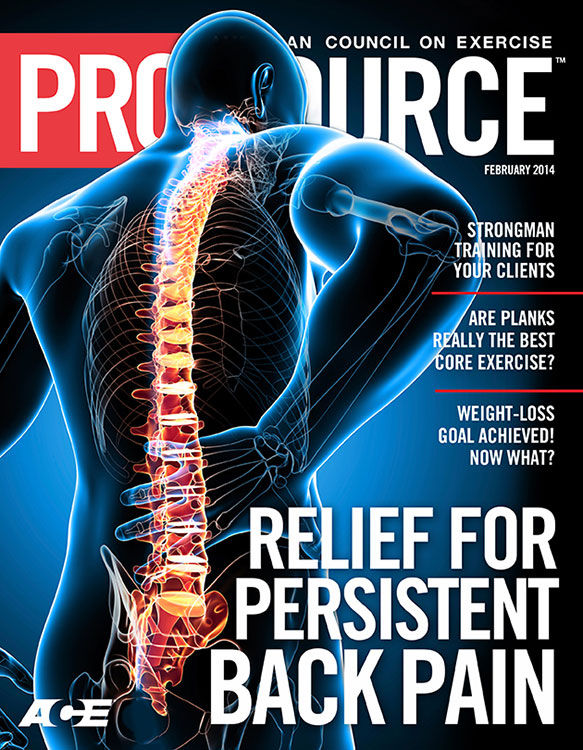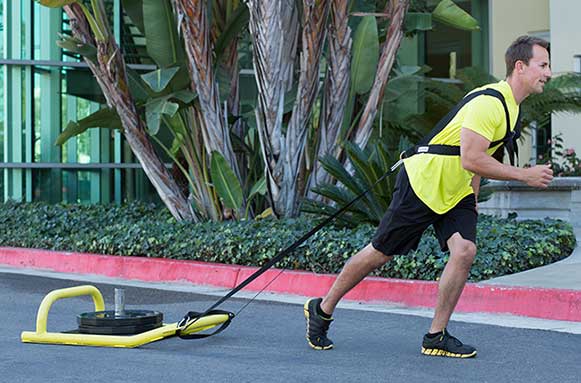
It’s late at night and sleep is elusive so you resort to flipping channels on the television. If you’re a fitness professional, chances are you saw something that caught your interest and you stayed fixed on that particular channel. No, it wasn’t an infomercial touting the latest way to develop six-pack abs (although they are ubiquitous), but a competition featuring oversized behemoths demonstrating amazing feats of strength. Long a fixture of late-night sports television, strongman competitions have become a popular activity for many recreational fitness enthusiasts, with as many as 9,000 athletes competing in North American Strongman sanctioned events. Carrying kegs, lifting logs, picking up stones, flipping tires and pulling cars have been a staple of strongman competitions for years, but are these exercises safe or effective for the average person? More importantly can you—or should you—consider adding some of these challenging exercises to your fitness toolbox?
Strongman Training and the ACE IFT™ Model
When it comes to popular exercise methods, the relationship between trends and research can often be a chicken-and-egg-type scenario. It is never quite clear whether a trend becomes popular because research demonstrates its effectiveness or if research on a trend after it becomes popular merely explains how and, more importantly, why it produces results. Strongman lifting techniques are an example of this relationship. While strongman competitions have been held for decades, a number of recently published studies suggest that strongman-style exercises may actually be beneficial for the average fitness enthusiast (Winwood, Keogh and Harris, 2011; Zemke and Wright, 2011; Keogh et al., 2010a; Keogh et al., 2010b; McGill, 2009). The results of these studies demonstrate the efficacy of strongman-type exercises and provide the rationale for adding them to workout programs for your clients or group fitness classes.
The Functional Movement and Resistance Training component of the ACE Integrated Fitness Training™ (ACE IFT™) Model of program design organizes the progression of intensity from foundational exercises for promoting joint stability and mobility to advanced exercises used to enhance athletic performance. While there is no specific rule dictating when clients can do a particular exercise, the recommendation is for beginning exercisers to use a majority of exercises from the Stability and Mobility phase and gradually increase the number of exercises from the Load and Performance phases as they adapt to the exercise stimulus.
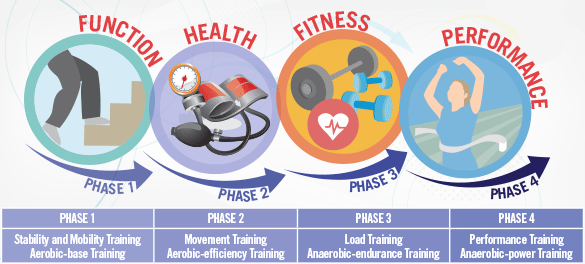
Due to the high levels of muscle force output required for success, strongman-type exercises can be classified in either the Load or Performance phases of the ACE IFT Model. Some strongman lifts require muscle endurance to maintain force output for a number of repetitions, while others require a large amount of force to be generated in the shortest amount of time possible. For example, a log lift requires competitors to perform an overhead lift for the highest number of repetitions, while lifting the Atlas stones require athletes to explosively lift a heavy load to an elevated platform (McGill, 2009).
There are a number of different events in a single competition and strongman athletes need to incorporate a diversity of strength and power exercises into their contest preparation. As a result of their comprehensive approach to exercise, strongman competitors are able to generate and sustain tremendous amounts of muscle force, and elite-level strongman athletes can be considered among the fittest athletes. In fact, a number of collegiate and professional strength coaches responsible for training athletes have started to incorporate strongman-training techniques into their conditioning programs (Winwood, Keogh and Harris, 2011; Zemke and Wright, 2011; McGill, 2009).
Benefits of Strongman Training
Strength competitions have been around as long as humans have been lifting heavy things. Olympic Weightlifting (weightlifting) competitions measure explosive strength in two specific lifts: the clean-and-jerk and snatch. Powerlifting competitions measure the total amount of weight lifted in three lifts: the squat, deadlift and bench press. Strongman contests feature a number of different implements to test competitors’ strength in a variety of different exercises. The three modes of competition are similar in that they measure an individual’s strength and ability to apply muscular force to overcome an external resistance. The differences are that Weightlifting and Powerlifting use a barbell to perform curvilinear movements occurring primarily in the sagittal plane, while strongman competitions test an individual's ability to move a number of irregular objects in a variety of different patterns.
With the exception of the bench press, the lifts used in Powerlifting and Weightlifting competitions (specifically the squat, deadlift, snatch, and the first and second pull phases of the clean-and-jerk) require a participant to move the weight with the feet positioned relatively parallel and approximately hip- to shoulder-width apart. This balanced stance may be an effective way to generate forces at the hips for the specific exercises in these competitions; however, many activities of daily living (ADLs) or athletic movements require an individual to apply muscle force with the feet in a variety of positions and very rarely in parallel. Powerlifting and Weightlifting emphasize the basic movements of pulling, pushing and squatting; strongman competitions feature these as well as other movements such as lifting, towing, throwing, swinging a hammer and walking while carrying heavy objects. Using strongman-type lifts may provide significant benefits by training individuals how to create and use strength in a number of different situations (Zemke and Glenn, 2011; McGill, 2010; 2009).
Understanding the Lifts
The tire flip is a common event in strongman competitions. In this event a truck tire is placed on its side and a competitor must lift it and flip it for a specific distance or number of repetitions. Flipping a tire may sound easy, but large truck tires can weigh upwards of 500 pounds, making them an effective means of testing total-body strength. Recent research by Keogh and associates determined that the tire flip is an effective way to integrate lower- and upper-body strength, so you may want to consider adding it to your repertoire (Keogh et al., 2010).
Another popular exercise used in strongman competitions is the sled pull or push. In this event competitors pull or push a special sled loaded with weights (or sometimes a heavy, over-sized vehicle) either a specific distance in the shortest time possible or the longest distance regardless of time. Recent research by Keogh and associates found that heavy sled pulling can be used to help athletes or sprinters improve acceleration and running speed. Pulling a heavy sled (or vehicle) trains athletes how to maintain a forward-leaning body position, while producing the strength to push into the ground one leg at a time to create the horizontal forces necessary to move the sled (Keogh et al., 2010).
Carrying events such as the Farmer’s Walk (FW) and Suitcase Carry (SC) require athletes to move extremely heavy loads while walking. The FW requires a contestant to hold two heavy objects, one in each hand, while the SC requires a competitor to hold a heavy weight on one side of the body. Each event challenges contestants to walk a specific distance in the shortest amount of time while carrying the load. The Keg Carry challenges strongman participants to place a liquid-filled keg (it wasn’t mentioned whether or not real beer was used, but the average keg contains 15.5 gallons and weighs approximately 140 pounds) on one shoulder and walk a set distance in the shortest time possible. While strongman training is often performed by men and women interested in maximizing their physical strength, the carrying exercises may provide benefits to a completely different athlete: runners. (The reasons why are discussed below.)
What the Research Tells Us
In general, there are two primary groups of muscles involved in joint movements: agonists, which produce the movement, and antagonists, which create an opposing force on the opposite side of the joint. In his research on strongman events, McGill found that muscles surrounding a particular joint must develop the strength and timing to co-contract simultaneously to create equilibrium and prevent unwanted movement in the three orthopaedic axes of rotation around that joint. The heavy loads and explosive movements used in strongman competitions train agonistic muscles how to rapidly “turn on” and produce the force to create movement, while simultaneously sending a signal to the antagonistic muscles to “turn off” and lengthen, allowing the joint to rapidly move through the full range of motion.
McGill found that the stabilizing muscles of the spine, in particular, became extremely effective at creating the stiffness that allowed the hip extensor musculature to produce the strength for lifts such as the Sled Pull and Atlas Stone Lift (McGill, 2010; McGill, McDermott and Fenwick, 2009). Based on these findings, strongman-type lifts may be an effective way to help clients prepare for activities such as picking up young children, shovelling snow or performing a number of household chores (husbands everywhere are jumping for joy). Older clients can perform modified versions of these lifts to simultaneously improve hip mobility and spine stability, which are essential for many common activities of daily living.
The tire flip trains athletes how to engage their hip muscles to generate the initial strength for the lift and then transfer it through the core to be used by the upper body, all while maintaining a stable spine. McGill notes that the power for the tire flip comes from the hips and is then transferred through the trunk for successful execution of the lift with the shoulders and arms (McGill, McDermott and Fenwick, 2009). McGill specifically observed that strongman athletes learn how to develop functional strength in a number of normally contraindicated body positions. For example, when performing the tire flip a number of competitors use their hips to generate the initial force, but do so with their spine in a shortened, rounded position to create a shorter lever arm which offers a greater advantage when moving the mass of the tire. It can be dangerous to place such a high amount of stress on the spine, but strongman training prepares muscles to control joint position in all three planes, which enhances safety by reducing unnecessary movement (Keogh et al., 2010; McGill, McDermott and Fenwick, 2009).
Runners often experience knee pain that can be related to the excessive adduction and internal rotation of the tibia, fibula and femur during the ground strike and mid-stance phases of the gait cycle. One way to address this issue is to strengthen the hip abductor muscles responsible for decelerating and controlling the movement of the femur in the frontal and transverse planes. When McGill studied the FW, SC and Keg Carry events, he found that carrying heavy loads while walking can help develop the strength of the hip abductor muscles to control pelvis-on-femur motion, which reduces the adduction of the femurs in the frontal plane. For example, when the left foot is on the ground and the right leg is swinging to prepare for the next step, the muscles that connect the lumbar spine to the pelvis and femurs (specifically the quadratus lomborum, internal oblique, gluteus medius and adductor magnus) work synergistically to maintain a stable pelvis (McGill, McDermott and Fenwick 2009).
Increasing pelvic stability can reduce the adduction of the femur, which creates lateral stresses at the knee when the foot is on the ground. Adding carrying exercises to the exercise programs for your clients that run could help them develop more effective contact when their feet hit the ground. Older adults can benefit by strengthening the muscles surrounding the hip, which can help increase their stability while walking and reduce the risk of breakage or fracture if they do happen to fall.
Using Strongman Lifts in Your Training Environment
It can be challenging (and expensive) to locate an old truck tire for the purpose of exercise, and your manager might look at you funny if you bring a keg with you to the gym, so it’s a good idea for fitness professionals look around their environment for equipment that can be used to replicate strongman-style exercises. (Note: Always be sure to read the manufacturer’s handbook about the equipment to ensure that you’re using it in a safe manner. It’s also a good idea to communicate with your facility operator to let him or her know your plans about using these unique lifting techniques.)
One option for replicating a Tire Flip is to place a 45-pound Olympic weightlifting plate on its side and challenge clients to flip it end-over-end. (Make sure you have a clearly marked path of travel to minimize the risk of interfering with other members.) Even though the weightlifting plate is hundreds of pounds lighter than the tire, the basic body mechanics between flipping a large tire and a full-size weight plate are approximately the same: hips flexed, stiff spine and a final push at the top from the upper-body muscles.

Another alternative for helping clients achieve the benefits of the Tire Flip is to use a ViPR. Place the ViPR lengthwise on the floor, have the client reach down, grab the top edge and explode up into hip extension to generate the momentum to flip the ViPR end-over-end. A second option is to use a heavyweight boxing bag as the resistance—lay it on the floor and flip it end-over-end for a specific distance.
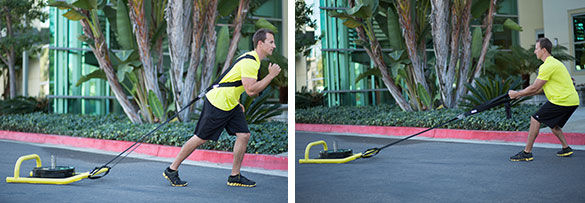
Sleds are an increasingly popular training tool and a number of health clubs are not only adding sleds, but also investing in indoor turf or rubberized running lanes to provide an optimal surface for using them. If a sled is not a viable option, place a weight plate (the heavier the better) on the floor (use a towel if exercising on a wood floor) and have your clients push the weights around the room. Whether the movement is technically pulling or pushing isn’t as important as coaching proper technique with full mobility through the hips and a stiff, stable spine.
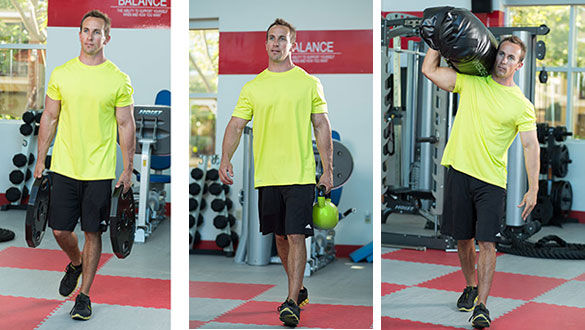
The FW, SC and Keg Carry are the easiest exercises to replicate in the gym. For the FW and SC simply have clients hold dumbbells, kettlebells or weight plates and have them walk. To increase grip strength have the client grab the end of the dumbbell instead of the handle. Rather than bringing a keg to work, have clients carry a medicine ball or boxing bag on their shoulder (be sure to use both shoulders during the workout). The carrying exercises are fun to include in a group workout; separate participants into teams and challenge them to compete in a relay to see which team can complete all of its carries first.
Sample Workout Using Strongman-style Lifts
This strongman workout can be incorporated into client's programs or your group fitness classes. When first introducing these exercises, have clients focus on execution of the movements as opposed to lifting the most amount of weight. Only increase the weight to maximal loads if it’s appropriate for the client and you have the proper equipment and space.

Putting it all Together
Exercise should be about having fun, and doing the same traditional exercises can become a bit repetitive and a little boring for both you and your clients. Making workouts more fun and engaging can not only improve adherence for your clients, but help you avoid the dreaded trainer burnout. Strongman training doesn’t need to use excessively heavy loads that test human capabilities to be effective. Use the exercises at an appropriate intensity to design creative, challenging and, most importantly, fun workout programs.
Keogh, J. et al. (2010a). A kinematic analysis of a strongman-type event: The heavy sled sprint-style pull. The Journal of Strength and Conditioning Research, 24, 11, 3088-3097.
Keogh J. et al. (May 2010b). A brief Description of the biomechanics and physiology of a strongman event: the tire flip. The Journal of Strength and Conditioning Research, 24, 3, 1223-1228.
McKeefery, R., Hedrick, A. and Bennett, S. (2009). Using ‘strongman’ exercises in training. Strength and Conditioning Journal, 30, 3, 42-44.
McGill, S. (2010). Core training: evidence translating to better performance and injury prevention. Strength and Conditioning Journal, 22, 3, 33-46.
McGill, S., McDermott, A. and Fenwick, C. (2009). Comparison of different strongman muscle activation and lumbar spine motion, load and stiffness. The Journal of Strength and Conditioning Research, 23, 4, 1148-1161.
Winwood, P., Keough, J. and Haris, N. (2011). The strength and conditioning practices of strongmen competitors. The Journal of Strength and Conditioning Research, 25, 11, 3118-3128.
Zemke, B. and Wright, G. (2011). The use of strongman type implements and training to increase sport performance in collegiate athletes. The Strength and Conditioning Journal, 33, 1-7.

 by
by 